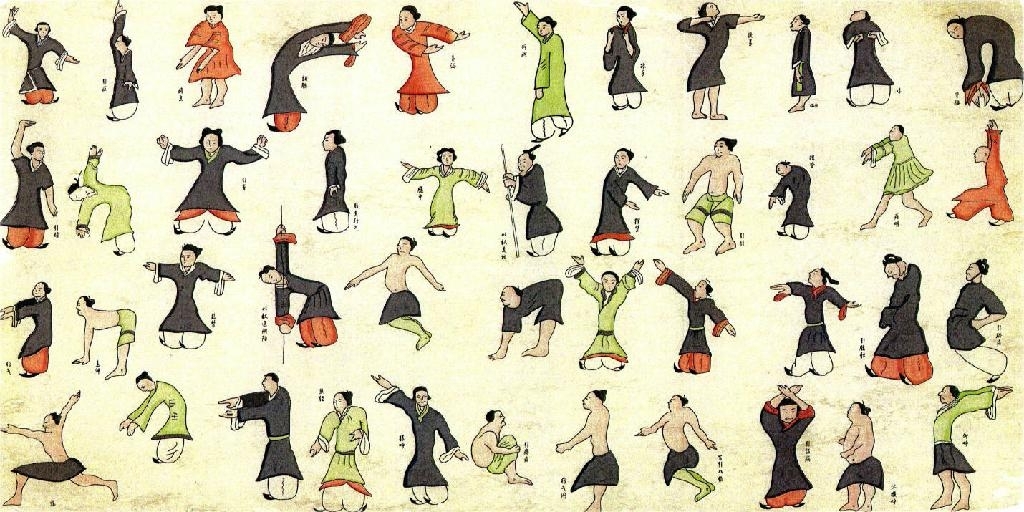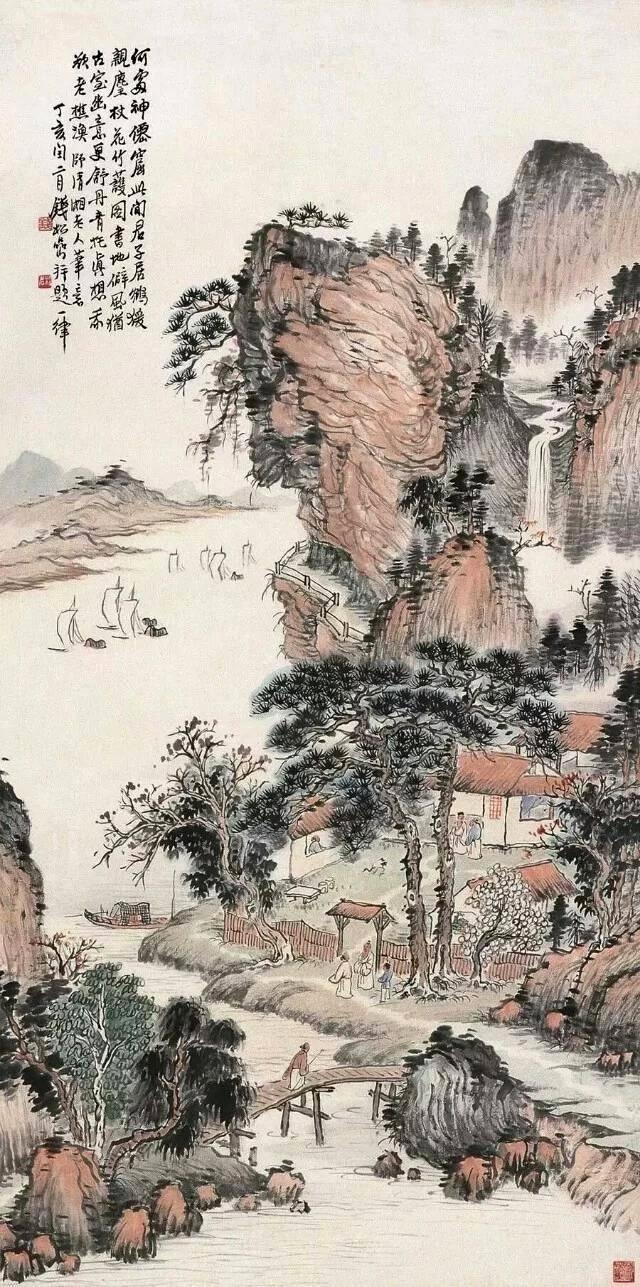|
|
|
|
|
|
|
|
Tai Ji Quan (Tai Chi )is a major division of Chinese martial art. Tai Ji Quan means “supreme ultimate fist”. Tai means “Supreme”, Ji means “Ultimate”, and Quan means “Fist”.
There have been different sayings about the origin of Tai Ji Quan. The traditional legend goes that the wise man Zhang Sanfeng of the Song Dynasty (960-1279) created Tai Ji Quan after he had witnessed a fight between a sparrow and a snake.
Tai Ji Quan has its philosophical roots in Taoism and is considered as an internal martial art, utilizing the internal energy, or Qi, and following the simple principle of “subduing the vigorous by the soft”. Taoism is the oldest philosophy of China which is represented by the famous symbol of the Yin and Yang which expresses the continuous flow of Qi in a circular motion that generates two opposite forces, plus and minus, which interact and balance with each others to bring existence to the physical and metaphysical world.

练太极常用英语:
抬头 raise one’s head
挺胸 square one’s shoulders
脚后跟着地 heel touches the floor
脚尖着地 tiptoe touches the floor
不要翘臀 don’t raise the buttock
伸腿 kick the bucket
伸直手臂 straighten your arm
曲肘 bend your elbow
推掌 push palm
曲腿 bend the bucket
太极 (Taiji) is the one exercise that can universally help solve our growing health crisis. With its gentle strength, tai chi moves us closer to feeling more alive and gives us the ability to realize our greater human potential.
Tai Chi is a good exercise method for health. Practicing Tai Chi Chuan you should exercise both externally and internally, physically and mentally, trying to keep the balance and unity of outer and inner part of the body. By imitating the movements of masters in our teaching stuff, you will find that your emotion, which is used to be up and down, calms down and self-control becomes an easy thing. What is more you will become aware of the great benefit, that is relaxation, a thorough relaxation. It is a very practical way for you to refresh from tension and exhaustion. 谢谢!
Today tai chi chuan is known across the world for its profound philosophy, beautiful choreography and health benefits.
First, tai chi chuan is based on the Chinese philosophy of yin and yang. Tai chi chuan maintains that maneuvers and motionlessness are equally important, as is the fast and the slow. Tai chi chuan might appear slow and calm, whereas in fact all still positions pave the way for motion and the slow is preparation for the fast. Therefore tai chi chuan is the combination of opposite energies.
Second, tai chi chuan is a type of boxing that believes in retreat for the sake of advance and in using the striking force of the opponent. Hence it's an art of the soft conquering the tough by dissolving an offensive move and reversal from passiveness to aggressiveness.
Third, tai chi chuan follows the theory of traditional Chinese medicine about energy passages within the human body and helps to cure illness and improve health. While helping to relax and stretch the body, tai chi chuan improves blood circulation, helps one concentrate and harmonizes the body and the mind.
Video 09
Authentic Yang Tai Chi 91t
Video 10
tAnnual meeting of entrepreneurs Tai Chi Exhibition
Video 11
Yang Tai Chi fourth layer frame
Video 12
Traditional Yang Style Tai Chi 28
太极拳英文基本用语 Tai Chi English basic words
掤、捋、挤、按、採、挒、肘、靠、进、退、顾、盼、定 Peng (warding off), Lv (rolling
back), Ji(pressing), An (pushing), Cai (pulling down), Lie
(splitting), Zhou (elbowing),Kao (body stroke), Jin (advancing),
Tui (retreating), Gu (shifting left), Pan(shifting right) and Ding (central equilibrium)
不丢不顶 no releasing and resisting directly
不解之谜 mystery
不偏不倚 impartiality
缠丝 twining
沉肩坠肘 lowering the shoulders and elbows
沉着 heavy and steady
撑掌 unfolding palm
抽丝 taking out the thread
丹田 Dantian (pubic region)
弹簧力 springy force
导引术 guidance 道 Tao;Dao

Zhang, San-feng’s (張三豐) Taijiquan Treatise states:
What are the thirteen postures? peng (wardoff), lu (rollback), ji (press or squeeze), an (press down, forward, upward), cai (pluck or grab), lie (split or rend), zhou (elbow), kao (bump), these are the eight trigrams. Jin bu (step forward), tui bu (step backward), zuo gu (beware of the left), you pan (look to the right), zhong ding (central equilibrium), these are the five elements. Wardoff, rollback, press, and push are qian (heaven), kun (earth), kan (water), and li (fire), the four main sides. Pluck, split, elbow, and bump are xun (wind), zhen (thunder), dui (lake), and gen (mountain), the four diagonal corners. Step forward, step backward, beware of the left, look to the right, and central equilibrium are jin (metal), mu (wood), shui (water), huo (fire), and tu (earth). All together they are the thirteen postures.
Taichi, Yin and Yang Theory
The yin and yang theory is used to classify everything, whether ideas, spirit, strategy, or force. For example, female is yin and male is yang, night is yin and day is yang, weak is yin and strong is yang. It is from the interaction of all the yin and yang that life was created and grew. Taijiquan is based on this theory and applies it to form, motion, force, and fighting strategy. In the thousands of years since the taiji theory was first stated, many taiji symbols have been designed. The best one for both theory and application is a circle that contains yin and yang. In this figure, the circle and the curved dividing line between yin and yang imply that both yin and yang are generated and contained in roundness. The smooth dividing line between yin and yang means that they interact smoothly and efficiently.

Traditional Yang's Tai Chi
Traditional tai chi was originally developed for self-defense, but tai chi has evolved into a graceful form of seated exercise that's now used for stress reduction and a variety of other health conditions. Often described as meditation in motion, seated tai chi promotes serenity through gentle, flowing movements.
Worthy of note is the growing popularity of seated tai chi exercises touted by the medical community and researchers. Seated tai chi is based primarily on the Yang short form, and is being used by the general public, medical practitioners, and tai chi instructors in a growing elderly population.
It would have been possible to simply take the well-known yang short form and redesign it for seated positions. There is, however, the matter of the integrity of the form itself. Within any tai chi form, there lies a certain inherent logic and purpose to each of the movements.
The synchronization of the upper body with the steps and the breathing exists in a very carefully crafted order developed over hundreds of years, and the transition to seated positions is an important factor in the movements themselves.
Research has shown that seated tai chi techniques can make big improvements to a person's physical and mental well being. Marked improvements in balance, blood pressure levels, flexibility and muscle strength, peak oxygen intake, and body fat percentages can be achieved.
Taiji is one of the Chinese Traditional martial ['mɑ:ʃəl] arts. Long long ago, it wasdesigned as a unique and profound self-defense technique. As an ancient Kongfu, Taiji includes quan, sword, broadsword, spear, push-hand,et cetera. Especially push-hand is well known for its tactic ['tæktik] and technique, the powerful and aggressive opponent [ə'pəunənt] being defeated by a small clever attack or an abrupt explosive [ik'spləusiv] power. As a typical artful Chinese Kongfu, hand push has been highly popular with the small and weak people.
太极拳是中国传统武术之一, 是很久以前作为一种独特而高深的自卫方法诞生的。作为一种古老的功夫,太极包括拳、剑、刀、枪、推手等。尤其是推手,素以技巧闻名,强大有力的对手被小而巧妙的攻击或突然的爆发力所击败。作为典型的技巧类的中国功夫,推手备受弱小者的青睐.
Concentrating on correct posture and breathing control, Tai Chi's movements are fluid['flu(:)id], graceful and well balanced, promoting the complete harmony of body and mind. Tai Chi provides the mental relaxation[,ri:læk'seiʃən] and physical fitness so essential in our modern stress-filled lives.
太极动作流畅、优雅、协调,它要求精力集中在正确的姿势和呼吸上,从全面促进身心平衡。在这个充满压力的现代社会,太极所带来的精神放松与身体健康显得尤为重要。
Tai Chi is an unusual form of martial arts whereby we believe in building strength - mental and physical from within, softness is stronger than hardness, moving in a curve[kə:v] is better than a straight line, yielding is more efficient than confronting. It is especially different from western types of sports such as rugby['rʌɡbi] where the harder and quicker the better. Tai Chi is a sport that strengthens the body as well as the mind from within.
太极是一项非同寻常的武术运动,它由内而外强健我们的身体和心灵 。在这项运动中,柔比刚更强,缠绕比直线运动更好,化力比正面冲突更有效。 和西方那些追求更快更强的运动如橄榄球不同, 太极强调的是从内而外地强健我们的身体和心灵。
No matter you are young or aged, male or female, no matter strong or weak, slim or plump[plʌmp], you all can choose Taijiquan as your ideal physical exercise. When practicing it quietly and slowly, you can sense the existing of air and fully enjoy the aerobic[,eiə'rəubik] bath, meanwhile you can also feel all the movements like the rhythmically['riðmikli] uninterrupted waves. Taiji--- the world of Yin and Yang, the world of the nature and relaxation[,ri:læk'seiʃən], will become your wholenew life style in the future.
不管男女老少、强弱胖瘦,你都可以选择太极拳作为你理想的锻炼方法。在安静舒缓的运动中,你能感知空气的存在,仿佛充分享受空气浴,同时你也能感觉到所有动作连绵不断,充满韵律。太极--阴和阳的世界,自然和放松的世界,必将成为你未来崭新的生活方式。
What are the benefits of tai chi?
In China, it is believed that tai chi can delay aging and prolong life, increase flexibility, strengthen muscles and tendons, and aid in the treatment of heart disease, high blood pressure, arthritis, digestive disorders, skin diseases, depression, cancer, and many other illnesses. Unfortunately, there hasn't been a good deal of scientific evidence to support these claims. In a special study of tai chi called a meta-analysis, where many studies on one subject are reviewed, the author concludes that although there is some evidence to support the positive effects of tai chi on health, fitness、 and balance, many of the studies are limited by small numbers of subjects and wide variation in the type and duration of tai chi used. Bearing these limitations in mind, here are some of the documented benefits.
Tai Chi is an ancient Chinese internal martial art system, which combines profound principles, theories and martial art techniques. The slow, soft and continuously flowing movements appear mysterious on the surface. However, it is the cultivation of one's internal energy, mind and the physical body that make it so unique and challenging. To generate relaxation, Tai Chi practice requires a deep level of concentration and a focused mind, thus allowing the mind to lead and guide the body's energy.
Tai Chi is not only a martial art, but has also been widely acknowledged as being an effective health exercise. Whether Tai Chi is practiced for health, as athletic sport or martial art it takes time, patience and qualitative practice to develop Tai Chi's internal properties. To achieve a high standard in Tai Chi training is a highly complex process.
|
|
|
|
|
|
|
|